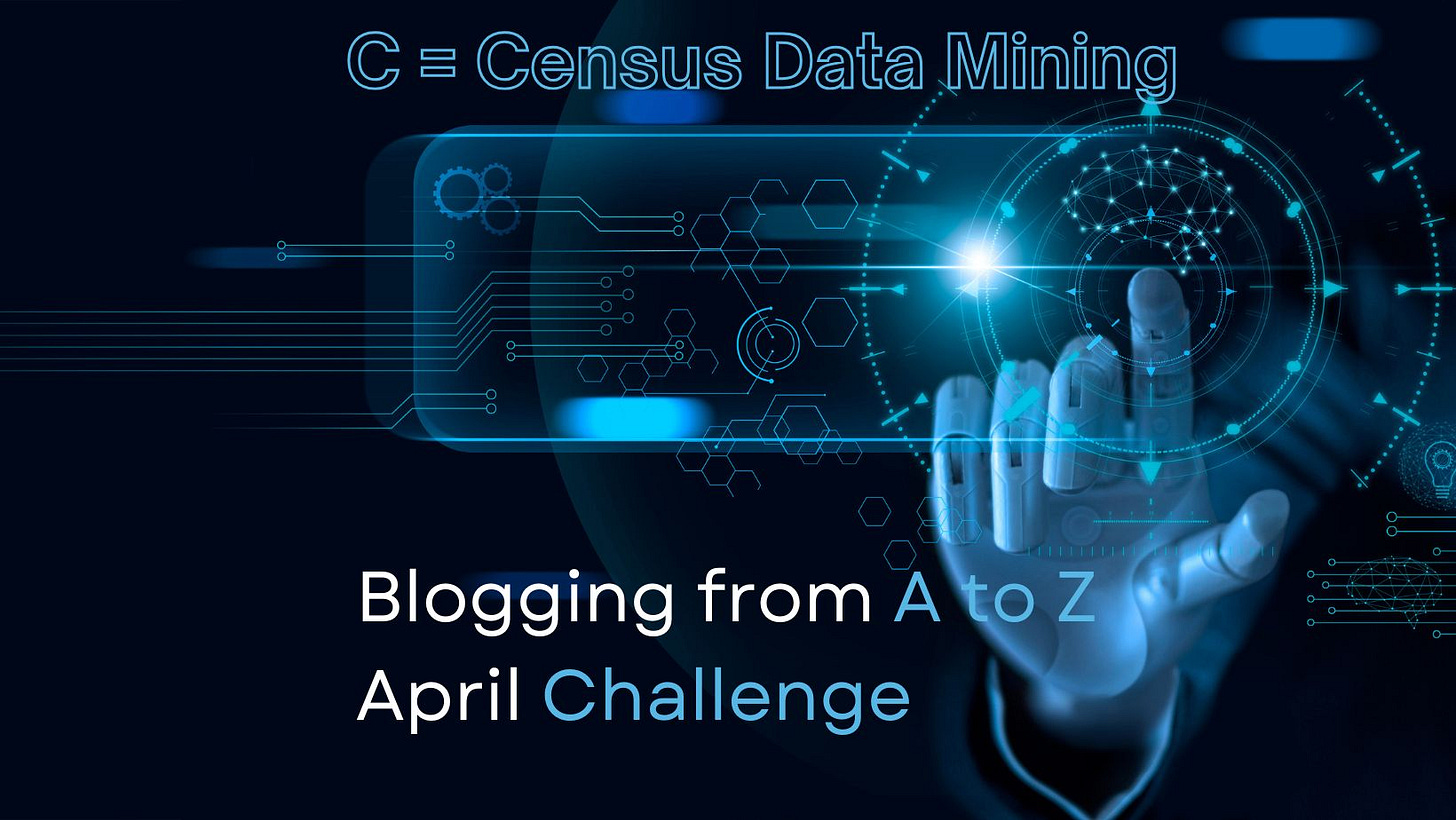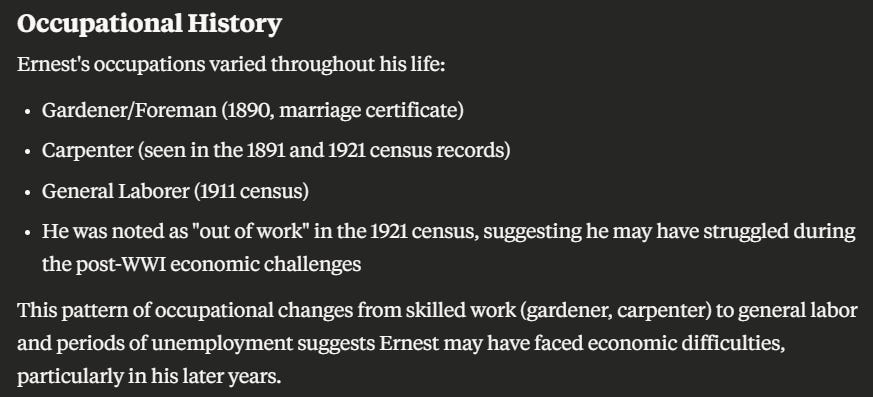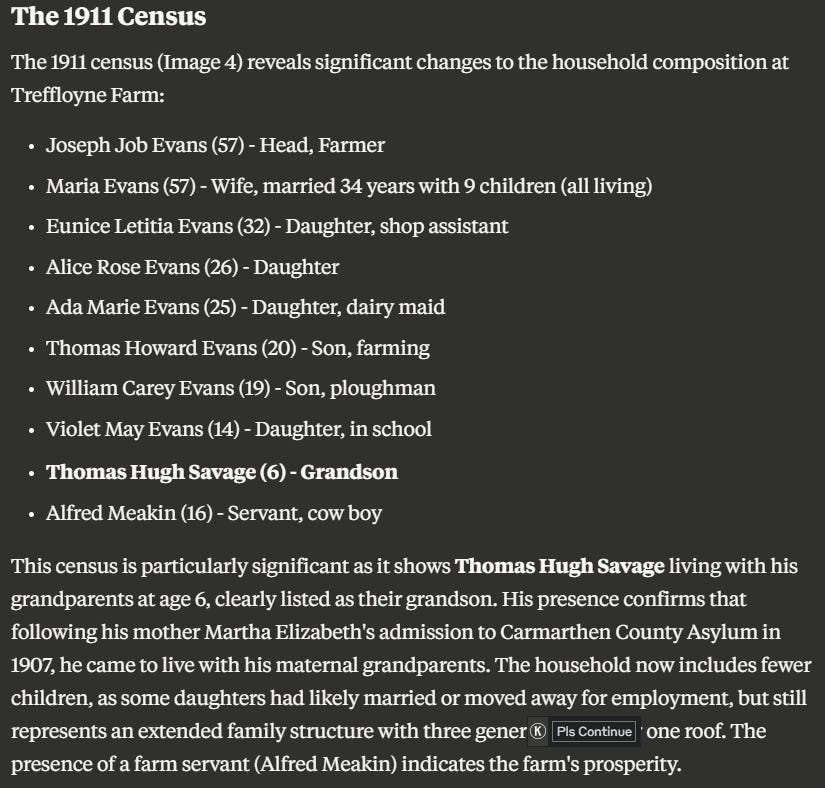I love the discovery of census records that display my ancestors; where they lived, who was in the household at the time of the census, their ages and places of birth, and sometimes the inclusion of other unrelated people, such as servants, employees, visitors, or guests. This year I am focussed on the census records from England, Wales, and Canada.
Census records have long been the backbone of genealogical research. These systematic snapshots of our ancestors' lives provide crucial details about family structures, occupations, migrations, and social contexts. However, the sheer volume of census data presents both an opportunity and a challenge. How can we effectively analyze thousands or even millions of records to identify meaningful patterns? This is where artificial intelligence enters the picture, transforming how genealogists extract insights from census data.
The Evolution of Census Analysis
Traditionally, genealogists have approached census records with a narrow focus—searching for specific individuals or families, one household at a time. While this approach serves the purpose of building family trees, it leaves untapped the wealth of contextual information and broader patterns contained within these rich historical documents.
The progression of census analysis in genealogy has moved through several stages:
Manual Lookup: Searching physical microfilm or books for individual entries
Basic Digitization: Keyword searches in digital databases
Advanced Search: Using filters and boolean operators to narrow results
Data Mining: Employing computational methods to discover patterns
AI-Enhanced Analysis: Utilizing machine learning to extract insights and predict connections
Today, we stand at the exciting intersection of traditional genealogical methods and cutting-edge artificial intelligence. Let's explore how AI is revolutionizing census data mining.
Key AI Techniques for Census Analysis
1. Natural Language Processing (NLP) for Occupation Analysis
Occupations listed in census records often contain valuable clues about social status, skills, family connections, and migration patterns. However, variations in terminology and spelling historically made large-scale analysis challenging.
AI-powered NLP can now:
Standardize historical occupation terms across multiple censuses
Identify related occupations that suggest family trade patterns
Recognize occupational hierarchies (apprentice, journeyman, master)
Connect occupation data with geographical information to reveal industry clusters
This capability allows genealogists to trace occupational legacies through generations, identifying patterns that might indicate family connections even when surnames change through marriage.
Case Study 1: Ernest James Goodall
Note: Claude will accept uploaded jpg files as you prepare your prompt.
Note: One transcription error - 1890 Builders/Foreman
2. Household Composition Analysis
Census records document household structures, but extracting meaningful patterns across large datasets was previously impractical. AI systems now analyze household compositions to:
Identify extended family living arrangements that weren't explicitly stated
Recognize patterns suggesting the presence of in-laws, even when relationships weren't recorded
Detect multi-generational occupation patterns within households
Flag unusual household arrangements that might indicate recent deaths, migrations, or economic changes
These insights help genealogists identify family connections that might otherwise remain hidden and understand the social context of their ancestors' lives.
Case Study 2: Joseph Job Evans
Note: Claude provided extensive responses to this prompt including 4 separate ‘artefacts’, see below.
Note: Below is part of the response regarding the household composition in 1911.
3. Geographical Pattern Recognition
AI excels at analyzing spatial data across multiple dimensions:
Tracking family migration patterns across consecutive censuses
Identifying clusters of individuals with shared origins (particularly valuable for immigrant communities)
Mapping occupational specializations by neighborhood
Correlating address changes with life events or historical developments
This geographical intelligence helps researchers understand not just where ancestors lived, but why they settled in particular areas and how their movements connected to broader historical trends.
Case Study 3: Thomas Hugh Savage
Note: Below is the Timeline of Thomas Hugh Savage with extracted data from the range of census records uploaded to Claude 3.7
4. Age and Life Stage Analysis
Census ages are notoriously inconsistent, but AI can help make sense of these discrepancies:
Identifying statistically probable birth years from inconsistent age reporting
Flagging anomalies that might indicate identity confusion or deliberate misreporting
Recognizing life stage patterns that suggest family relationships
Correlating age data with historical events to identify impacted generations
These capabilities transform age information from a simple biographical detail into a powerful analytical tool.
Case Study 4: Evans Family
Note: Uploaded census records to Claude 3.7
Mystery: Who was Martha Davies?
5. Name Variant Clustering
Names in census records vary tremendously due to spelling inconsistencies, transcription errors, and actual name changes. AI now offers sophisticated approaches to this challenge:
Clustering phonetically similar names across multiple censuses
Identifying regionally specific naming patterns
Connecting naming conventions across related families
Tracking surname evolution through time in specific communities
This technology helps researchers follow families even when their names change substantially across different records.
Practical Applications for Genealogists
Identifying "Missing" Family Members
One of the most powerful applications of AI-enhanced census analysis is locating individuals who seem to disappear from records. By analyzing household patterns, occupational signatures, and neighborhood characteristics, AI can suggest candidates who might be the "missing" person under variant spellings or in unexpected locations.
Reconstructing Community Networks
Traditional genealogy focuses on direct ancestors, but AI-powered analysis of census data can reconstruct entire community networks. By identifying patterns of proximity, shared origins, occupational connections, and household arrangements, these systems can map the social environment in which ancestors lived—often revealing previously unknown family connections.
Validating Family Relationships
When documentary evidence of relationships is missing, AI analysis of census patterns can provide supporting evidence. Systems can identify statistical probabilities of relationships based on household composition, naming patterns, occupations, and migration history, helping genealogists build stronger cases for suspected connections.
Breaking Through Brick Walls
For genealogists facing research dead-ends, AI analysis of census data offers new pathways forward. By identifying unusual patterns, statistical anomalies, or unexpected connections across large datasets, these systems can suggest fresh research directions that might bypass long-standing obstacles.
Read the article for B = Breaking down Brick walls
The Future of Census Data Mining
As AI technology continues to evolve, we can anticipate even more powerful analytical capabilities:
Cross-Record Integration
Future systems will seamlessly integrate census data with other record types (vital records, tax lists, city directories, church registries) to
create comprehensive views of individuals and families through time.
Predictive Analysis
Advanced AI will predict likely locations of ancestors in not-yet-indexed records,
estimating where individuals might appear based on patterns from previously analyzed data.
Automated Family Reconstruction
We're approaching a point where AI can automatically suggest probably family structures based on collective analysis of multiple census years,
flagging candidates for human verification.
Visual Pattern Recognition
Emerging technologies will analyze visual patterns in original census images that might be missed in transcriptions,
such as notations, marks, or handwriting characteristics that provide additional information.
Ethical Considerations
As with all technological advances, AI-powered census analysis raises important ethical considerations:
Privacy concerns for more recent census records with living individuals
Algorithmic bias that might perpetuate historical recording inequities
Over-reliance on automation potentially leads to uncritical acceptance of suggested connections
Accessibility gaps between researchers with and without access to advanced analytical tools
Responsible genealogists must approach these powerful tools with an awareness of both their capabilities and limitations.
Best Practices for AI-Enhanced Census Research
To effectively leverage AI for census analysis while maintaining genealogical standards:
Verify AI-suggested patterns through traditional research methods
Document your analytical process, including the tools and methods used
Consider the historical context when interpreting AI-identified patterns
Share your findings with the wider genealogical community to enhance collective knowledge
Maintain a healthy skepticism, treating AI suggestions as hypothesis-generating rather than conclusive
Consider AI-enhanced Census Data Mining
AI-powered census data mining represents a transformative approach to genealogical research. By moving beyond individual lookups to sophisticated pattern analysis, these technologies enable genealogists to extract deeper insights from familiar sources, identify previously invisible connections, and develop richer understandings of ancestral communities.
The most effective approach combines AI's computational power with the genealogist's historical knowledge and critical thinking skills. Together, these complementary strengths transform census records from simple population listings into dynamic maps of family and community relationships through time.
As you incorporate these techniques into your research, you'll discover that census records—even those you've examined many times before—contain layers of information and connections waiting to be revealed through the lens of artificial intelligence.
Ready to elevate your genealogy research with AI? Come and learn how to become an AI-skilled ancestral storyteller in the course, "Beyond the Pen: Using AI to Transform Ancestral Storytelling." Discover practical techniques and ethical approaches to incorporating AI into your family history work. Join us at Beyond the Pen and transform how you preserve your family's legacy!
I look forward to seeing your case studies that illustrate these AI techniques in action! What census data mining discoveries have you made in your research? Share your thoughts in the comments below.

















I’ve not been able to get any AI to read American census records consistently across all the columns. I’ll have to give it a go again, perhaps something changed.
I love research so this was fascinating.